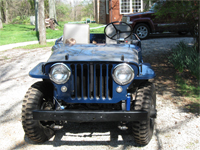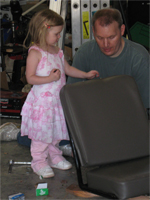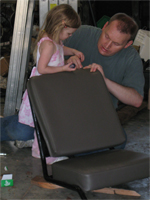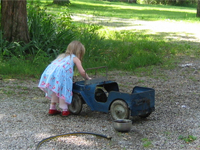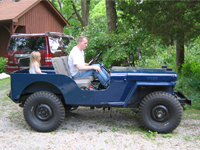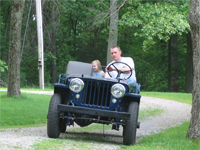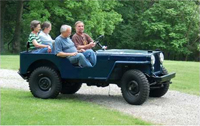
Project "Ole Blue"
Part 17 – In (and under) the hood
Spring has arrived and so does the hope of hitting the road. Just a few more tasks and Ole Blue should be ready to hit the highway, or at least the fields. Blue has been reassembled except for bolting on the hood and adding new seat cushions and backs. While not required for road testing, having those items in place seemed real signs of progress.
Ole Blue’s only remaining original sheet metal is the hood. It has lots of lumps and bumps that we did our best to bang out before it was painted. Our body shop guy did say “You know that dark blue is really going to make the dents show up.” He was right, and against the smooth new fenders and body some of the bumps and lumps look even bigger. But those are marks of a jeep life well led and we will honor them by leaving them for all to see.
All in the family
The best part of this ongoing journey has been the time Evan and Barry have spent together. Add to that the involvement of past and present family and we have a wonderful, shared adventure. Maddie has become a regular member of the crew. While there is some sitting and watching, Maddie likes to be involved. So when the time came for putting the new seat cushions and backs on the frames, Maddie was there with her screwdriver.
Sometimes Maddie just likes to work on her own 2a. On a warm spring day, she declared to her dad that it really needed to be washed. She is truly a member of this jeep family.
Under pressure – or not
Our first test of the engine was done with an oil pressure gauge installed. On cold starts, the pressure was around 25 psi. Good enough. Later, when we were able to go for short test runs, we noticed that the pressure was dropping to near zero at normal operating temperatures. This was very different behavior from Ole Yeller, whose oil pressure starts around 40 psi and only drops to about 25 psi when the engine is at operating temperature. Something must be wrong.
Our first thought was that we might have caused a blockage when we cleaned the oil pan; perhaps we had loosened some sludge when we wiped down the pickup screen. Or maybe we just needed a new oil pump. After all, this engine is 64 years old (we believe) and we don’t know how many hours/miles it has on it.
We decided to attach another pressure gauge, just to make sure the new gauge wasn’t at fault and to get a more accurate reading. We installed an inexpensive gauge in the engine compartment from the auto parts store as a quick test. When we failed to get the connections good and tight, we at least knew we had some pressure as oil shot out as soon as the engine was started. The new gauge showed about 5 or 6 psi at operating temperature. That seems low.
Back to the well
Before ordering a new oil pump, we thought a little research was in order. Just how big of a job will this be? We turned, as we have so many times, to the well of knowledge to be found in the many jeep forums. Among the hundreds of “low oil pressure” topics were several that listed the “normal” idle pressure as low as 6 psi. The 1947 CJ2A operator manual shows “(s)tandard gauge reading is approximately 35 at 30 miles per hour and 10 at idle speed.” So at least for the moment, we will live with the low readings. But before we do much highway driving, we will revisit this issue.
Taking a back seat
The major advantage of a Newgren lift is the bed remains open, for hauling bags of feed, fertilizer or friends. Ole Blue came with no seats, so we aren’t sure if a rear seat had been installed. For our purposes, we purchased a reproduction rear seat. Maddie, having assisted in installing the seat cushions volunteered to be our tester. When our friends Rick and Deb visited, we all loaded up for drive around the yard and more testing. Ole Blue looks like a real jeep, ready for a trip to town.
Time lines
The test trips around the yard and down the drive showed some high-speed engine issues. Ole Blue starts easily and idles smoothly. But under load, the engine is lugging, hesitating and, occasionally, back firing. Most likely, we believe these are timing and/or carburetor issues. We will start with timing, since we have installed new points and might not have them set properly. Besides, setting the timing is easy right? Just aim your timing light at the timing marks and turn the distributor until the marks align.
The timing marks on our engine are etched into the flywheel and are visible through an inspection hole at the bottom of the bell housing – if you stand on your head. Using a mirror (in place of head standing) we hooked the light up to the No. 1 plug and started the engine. No lines or markings were visible. By turning the engine by hand and still using a mirror to look inside the inspection hole, we did locate the set of markings. Why couldn’t we see them with the timing light? Perhaps we needed to apply some white paint so they would show more clearly. That didn’t help.
Back to the Web and more searches on timing. This time, Barry stumbled across a note about some early flywheels being installed 180 degrees out – instead of lining up with the No 1 cylinder, they align with the No. 2 (fourth in firing order) cylinder.
Next up – Timing is everything
Barry’s notes –
Evan’s notes –

